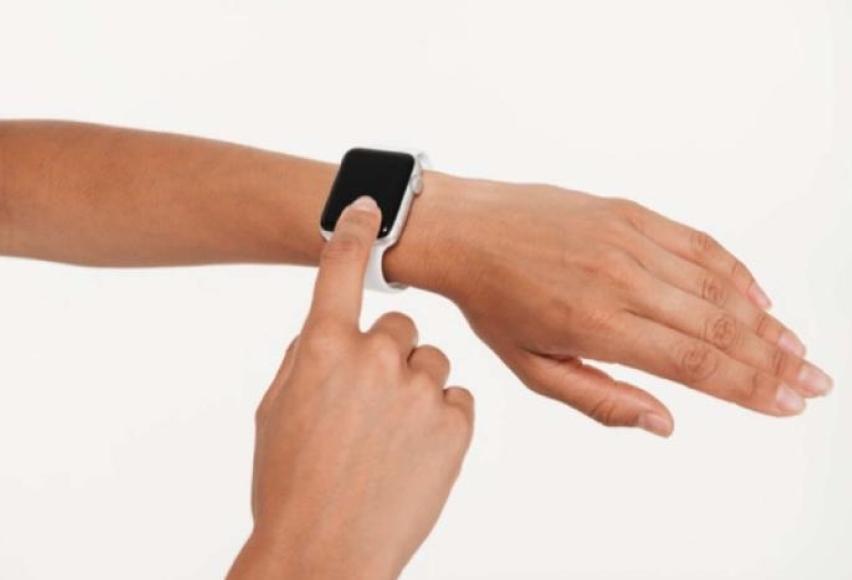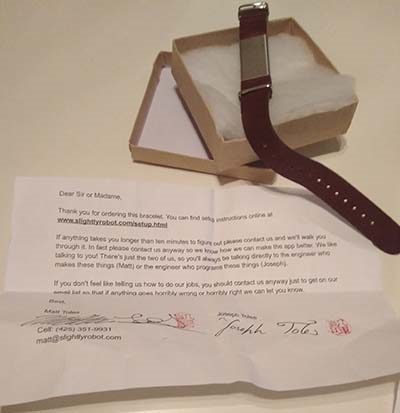Slightly Robot Review

Online test
Find out the severity of your symptoms with this free online test
The wearables market is booming and this wave reached the mental health fields too. What is significant to our readers is that some of those companies are focused specifically on BFRB disorders such as excoriation disorder and trichotillomania. We decided to reach out to all vendors who are creating devices for the BFRB market, and put their products to the test. This is going to be the first post in a series of reviews dedicated to such devices. This following is a thorough review by a member of our team:
Hello – Slightly Robot
SlightlyRobot is a young and small venture run by two brothers from Seattle (we interviewed them last fall). As their website states:
“The Slightly Robot Bracelet tracks your hands and vibrates when you forget what they're doing, whether it's pulling your hair, biting your nails, or something else.”
Do I Have Trichotillomania?Check the severity of your hair pulling symptoms with this free online test
Beside a bracelet, they also developed an app, which can work not only with the bracelet but with any android wear watch. Why use the bracelet and not an android watch to begin with? Well, the main reason is (according to their answers in our interview) is that smart watches tend to be pricey. Their app is released for free, so if you own a watch running android wear– you might want to use it instead of buying the Slightly Robot bracelet.
We got their bracelet by mail, it arrived in a minimalist packaging:

Inside the packaging was the bracelet, with instructions on how to use it, and a charger.
The bracelet
The bracelet comes in a very minimalist design. It’s very light and comfortable on the hand and has a modest look. The one we got has a brown leather strap, but they come in various colors (and with nylon straps too). The device itself has no indicators (lights like you have on your smartphone), no screen, no buttons (not even on/off switch), and actually nothing to indicate that it is not a piece of jewelry (except maybe the charger interface which is almost invisible when wearing the device). This minimalism, while making the design cost-effective, has its drawbacks. For example, the lack of a battery indicator means there’s no way to know when the battery needs recharging.
First use
Wearing it is one thing. Getting it to work is a bit more complicated. The device does come with a page containing very simple instructions, and with a small referral to their website for more.
First, you need to download their app (we used an android phone for this review and downloaded the app from google play).
The app is simple – you have the ability to connect two bracelets (one for each hand). The app records your calibrated activities (more on that later) and can show you handy graphs (recorded data by day of week and hour of day).
Once you connect to a bracelet (via Bluetooth) you see this screen:

The three lines that move as you move your hand, indicates that the bracelet is connected to your phone and that tracking is taking place.
Now the tricky part: how to setup the tracking.
There are two parts to this process: first, understanding how the device works, and second, setting it up.
How does it work?
It could be a bit counter intuitive at first. You might expect the app is measuring the location of the bracelet in space (related to some initial position) – which is the most intuitive thing to expect. However, it turns out (and it took us two days of use to figure it out) – what’s measured is the bracelet’s orientation, rather than position. (orientation = where the device is pointing at in space).
The whole idea is based on the premise that, each unique action of your hand (BFRB related such as pulling hair or non BFRB related such as typing on the keyboard) has a unique bracelet orientation associated with it (at least with high probability – more on false positives later).
How to set it up
Once you get an idea of how it works, you’re ready to set it up.
This depends on the kind of BFRB activity you’d like to monitor. For example, for hair pulling you might want to raise your hand to touch your hair. Once your hand is in that position – you should click on the “calibrate” button in the app. From now on, each time your hand is in that position – the bracelet will vibrate (and continue vibrating once in a few seconds – until you move your hand to a different position).
That’s it – very simple when you understand how it works.
What’s less clear is that you can calibrate a few hand positions. Basically each time you click “calibrate” a new position is added to the list (with the confusing name “default title”). It took us a while to understand what’s going on here – there’s certainly room for improvement in the app’s GUI here.
Everyday use
Once everything was setup we put the app/bracelet to daily use. Here are our main impressions:
- False positives – maybe the biggest problem of Slightly Robot. When using the bracelet, a lot of times the bracelet vibrates when you’re not doing anything close to the activities you calibrated it for. For example, when you drink your coffee or talk on the phone, the bracelet’s orientation might be the same as for hair pulling. This is not a problem in the bracelet, but rather in the whole idea of how it works. You can say it’s not meant to be accurate “by design”. It’s important to add that false positives by themselves are nothing bad (except the fact that they feed irrelevant data into the app). The biggest problem with false positives is that the vibration is loud! Which brings us to the next issue...
- There is no possibility to control the level of the vibration. This is a problem especially for people who wear the bracelet around other people (it can be anything from a classroom to a dinner table). The default vibration level is loud, so much so that it is easily noticed by those around you.
- Often times the device simply disconnects and it does not automatically connect back. Maybe this is some kind of bug. We made sure to keep the phone and the bracelet near the whole time, so it was not a problem with Bluetooth range.
- The bracelet can be effective only when you’re in a vertical position (ie sitting straight, standing) – it becomes irrelevant when you’re lying down, or sitting back in a chair. Again, this is not a problem in the device – it is so “by design”.
- Battery life – it says on the website 24+ hours. We found it to be much more than that (a single charge can keep the device alive for a few days).
Update (as of July 13 2017)
We reached out to the Slightly Robot team after writing this review, and they were extra quick to respond, and not merely with words but with actions:
- In the new version of the App, there's a slider to adjust the intensity of the bracelet's vibration.
- Some new tweaks were added to the App's GUI to make onboarding of new users easier.
- Regarding false positives, they recommend increasing the trigger time in the settings menu to a longer time, so that the hand must remain in the same position for a short while before the bracelet vibrates. The time should be longer than, for example, taking a sip of water, but shorter than the time it takes to pick/pull, perhaps 3-4 seconds.
- They also promised to add a battery indicator to the App
- They also explained that they're working on a new version of the device which will be called "Model 2" - so this was a review of "Slightly Robot Bracelet Model 1".
Conclusion
This is the first bracelet Slightly Robot introduced to the market. Considering this is a new venture, and it’s their first product they have made a good start. It’s a simple device, that will be more effective for some than for others (greatly dependent on the type of BFRB being tracked). There’s clearly a lot of room for improvement in areas such as onboarding, app GUI and being able to control vibration level (update - a lot of those issues were addressed immediately after our review - hope to see an even bigger progress in "Model 2").
All in all, if you’re looking for a wearable to increase your awareness of your BFRB, and you’re willing to live with the above mentioned drawbacks – it’s definitely worth a try.
We hope that the guys @ Slightly Robot will continue to listen to feedback from their users, and that future versions of their bracelet will do an even better job at helping people suffering from BFRBs managing their compulsions.
Online test
Find out the severity of your symptoms with this free online test
Start your journey with TrichStop
Take control of your life and find freedom from hair pulling through professional therapy and evidence-based behavioral techniques.
Start Now



